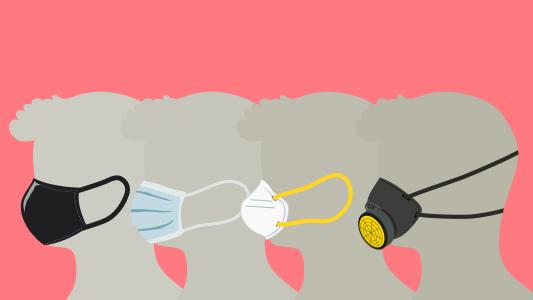A growing number of coronavirus victims — counted among the recovered and discharged from the hospital — still suffer from long-term health effects of COVID-19, with lungs of ground glass and limbs burdened by chronic fatigue.
These lingering effects are not limited to just the most severe cases, either.
“To date, (long-term complications) isn’t shared only among patients with the worst disease presentation at the diagnosis time but also among young healthcare workers who reported mild symptoms,” Emanuele Pivetta, an emergency department doctor in Turin, Italy, wrote to Freethink via email.
It’s far too early for longitudinal studies to figure out the long-term health effects of COVID-19, much less how to treat them. But as the hourglass turns for more and more patients, doctors and researchers are beginning to understand what the lasting damage could be.
Harder to Breathe, Harder to Move
SARS-CoV-2 most famously and viciously attacks the lungs, and the difficulty breathing and coughing appears to be staying with some patients beyond their initial infection. Lung issues could be hallmark long-term health effects of COVID-19.
This may be because the virus induces an unusually imbalanced immune response, the result of which is a destructive cytokine storm that can have fatal consequences. (Researchers are scrambling to find Galilean interventions.)
But those who survive the virus and their own immune system’s scorched-earth counterattack may still be left with the scars of war.
Accounts in The Atlantic and Vox feature patients with difficulty breathing, weeks or even months after being infected, smoldering sensations in their lungs and a persistent cough.
Lung CT scans of COVID-19 patients have shown “ground-glass opacities,” light gray patches denoting damage where the lung scan should be black.
“These kinds of tissue changes can cause permanent damage,” Ali Gholamrezanezhad, a radiologist at the Keck School of Medicine at the University of Southern California, told Vox.
Even the earliest survivors have not lived without the virus long enough to tease out the long-term health effects of COVID-19. But researchers can examine cases caused by its coronavirus cousins, SARS and MERS.
Impaired lung function has been found in SARS patients four years after recovery. The news is not all doom and gloom, however; a longitudinal study published in Nature found that lung damage did eventually heal, although a third of patients had reduced lung capacity. Small studies have found similar results in patients with MERS.
For some of these patients, their ability to do normal activities never fully recovered, Gholamrezanezhad said.
Chronic fatigue has also been reported as a long-term health effect of COVID-19. The CDC reports that the criteria for chronic fatigue syndrome have been met in a quarter of COVID-19 patients, University of Virginia physician and professor William Petri wrote in The Conversation. Such effects could be caused by lung impairment.
Vonny LeClerc, a Scottish journalist who had not been tested when she spoke to The Atlantic but had been told by numerous doctors she definitely had the disease, could hardly stand in the shower and would be wiped for days after a trip to the grocery store.
“It’s like nothing I’ve experienced before,” LeClerc said.
Intensive Care’s Lasting Impact
One long-term health effect of COVID-19 could be caused in part by the virus itself, but is also a recognized risk in anyone who spends time in intensive care: delirium.
Delirium is a regrettably common side-effect of a stint in the ICU. Marked by confusion, reduced awareness of one’s environment and self, difficulty focusing, hallucinations, disorientation, inability to focus, and a legion of other things, the condition can persist for a time even after a patient leaves the ICU.
The understandably disorienting hospital experience can contribute to delirium. So does the use of sedatives, which may be necessary to keep already suffering patients from interfering with their own care, or handling the discomfort of assisted breathing.
Compounding the problem, a shortage of sedatives in COVID-crushed hospitals means doctors have been turning to benzodiazepines. This class of drugs — you probably know it from Xanax — can cause “intense and prolonged delirium,” E. Wesley Ely, a critical care physician at Vanderbilt University, told Science.
Another problem is caused by SARS-CoV-2 itself. The virus’s infectiousness can make staving off delirium difficult. Bedside interactions that could calm patients, or protocols to ease up on the sedatives to see if they are still needed and take some time to process and walk through what is happening, are more difficult due to risk of infection and the sheer time crunch on hospital staff.
In the face of a novel pandemic, tried and true interventions can become difficult to implement, and new treatment methods developed on the fly.
Limiting the Long-term Health Effects of COVID-19
There are steps being taken to help potentially limit the long-term health effects of COVID-19.
Early intervention may be the biggest determining factor in protecting against long-haul problems. About 90% of the patients he has treated in Hong Kong have appeared headed towards full recovery a month out, University of Hong Kong professor of medicine Ivan Hung told the Japan Times. He attributed this potential success to the city’s ability to diagnose, and therefore treat, COVID-19 patients early.
Moving the limbs — while avoiding infection — may help avoid atrophy.
Teams at Johns Hopkins’ ICU are putting on PPE to help move the limbs of patients on ventilators. These patients are susceptible to muscle atrophy, the muscles wasting away while their owner lies motionless. Moving the limbs — while avoiding infection — may help avoid atrophy.
Doctors are also trying to better triage who needs ventilation and who can be treated with less invasive — and therefore less intensive — measures. This may reduce the need for sedatives, helping alleviate the long-term health effects of COVID-19 on cognitive function.
Tracking the Survivors
Keeping up with survivors of the infection and developing a sharp picture of the long-term health effects of COVID-19 will be crucial moving forward, as humanity stares down a future in which SARS-CoV-2 circulates among us.
Such studies have two aims, Pivetta, the emergency department doctor in Turin, writes; to better understand both the sickness and the virus which causes it.
“During previous new coronavirus infections, we didn’t need to deeply understand the virus,” Pivetta writes.
“But COVID-19 is different. The follow up could give us more insights about its mechanism of contagion, of damage, and its possible mutations.”
They are insights that could potentially save lives, and ease the suffering of long-haulers, currently trapped in a liminal space between struck down and strolling around.






